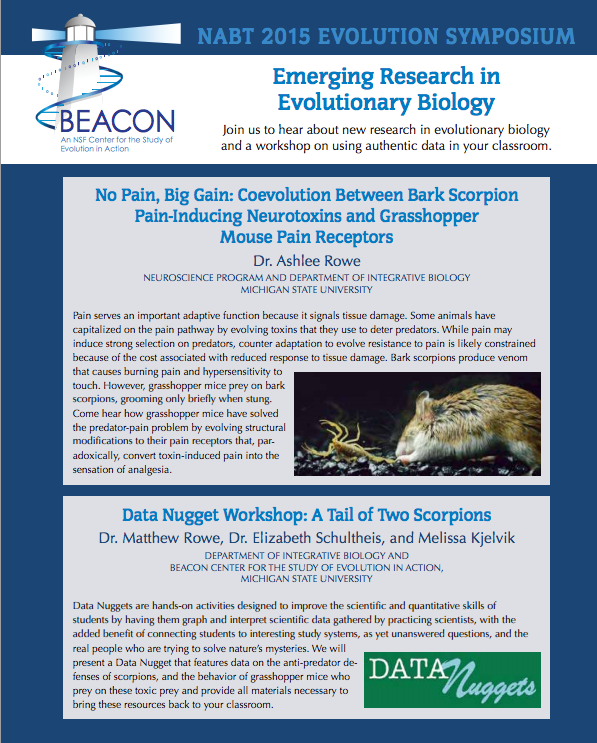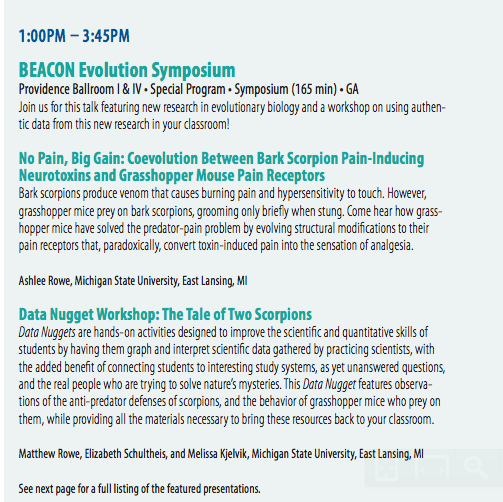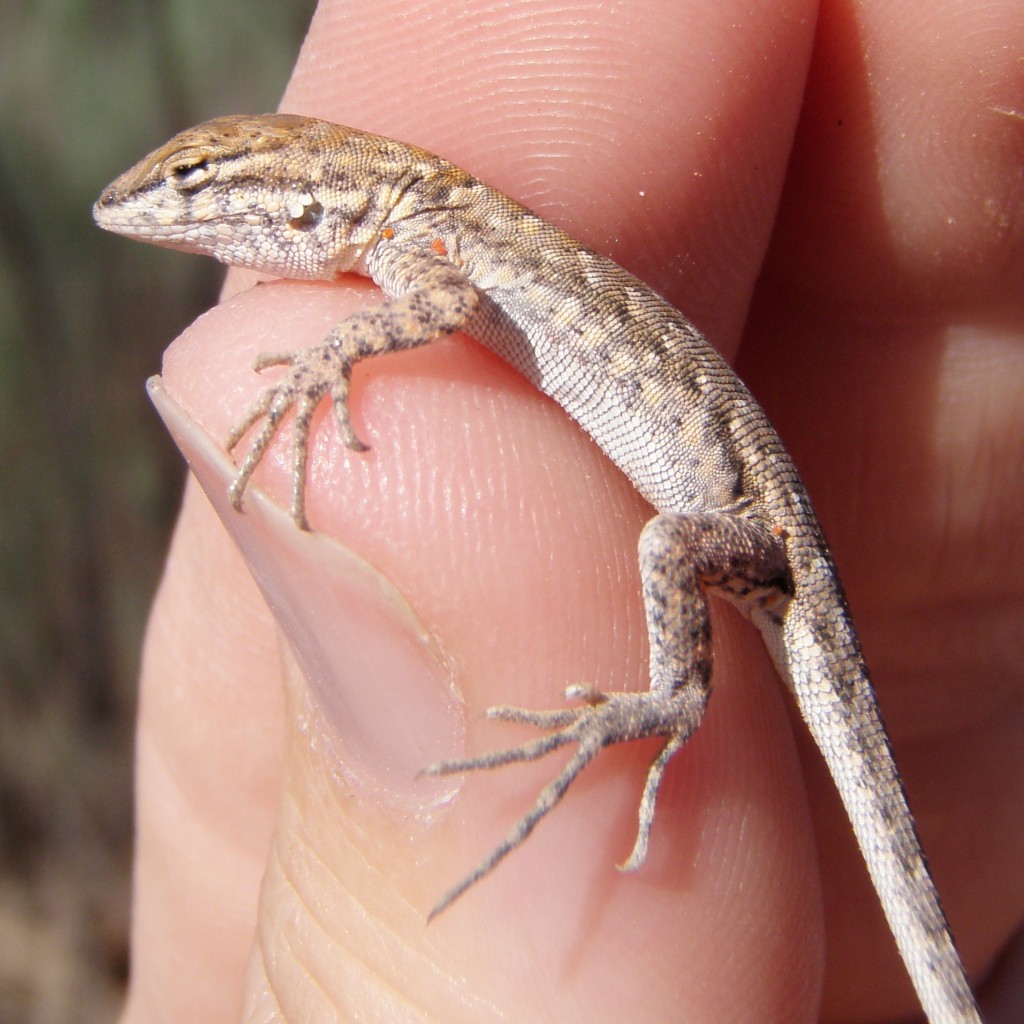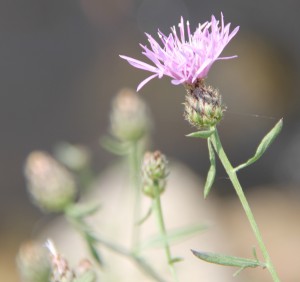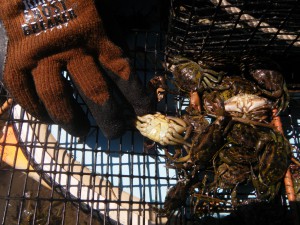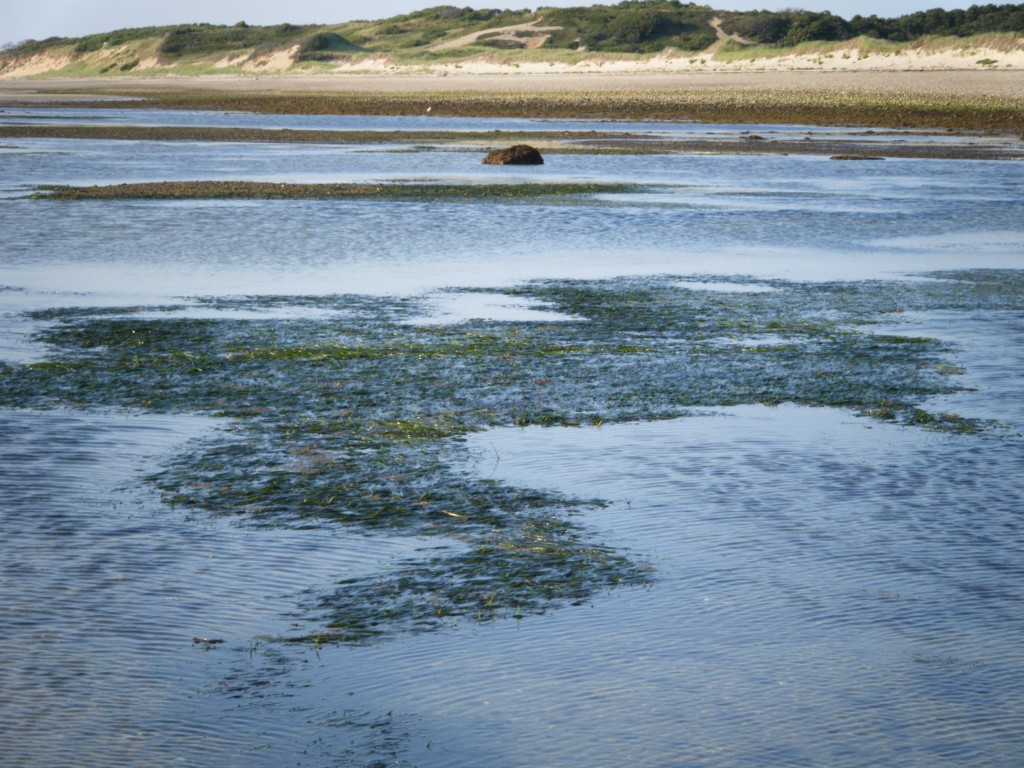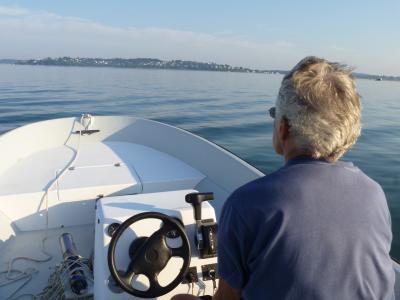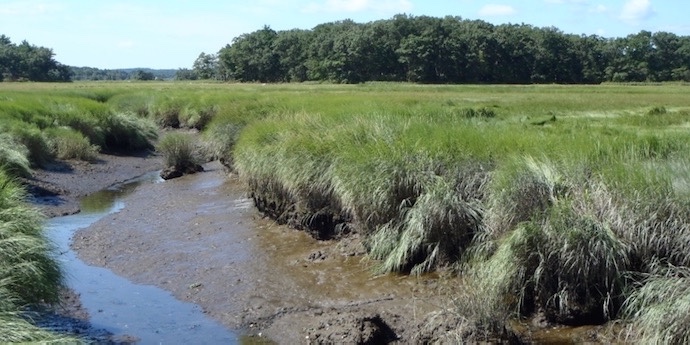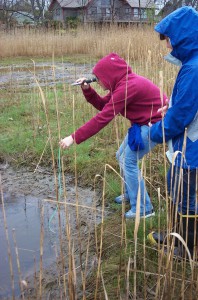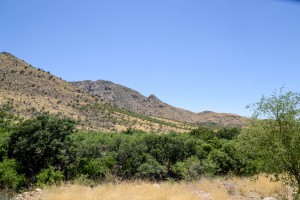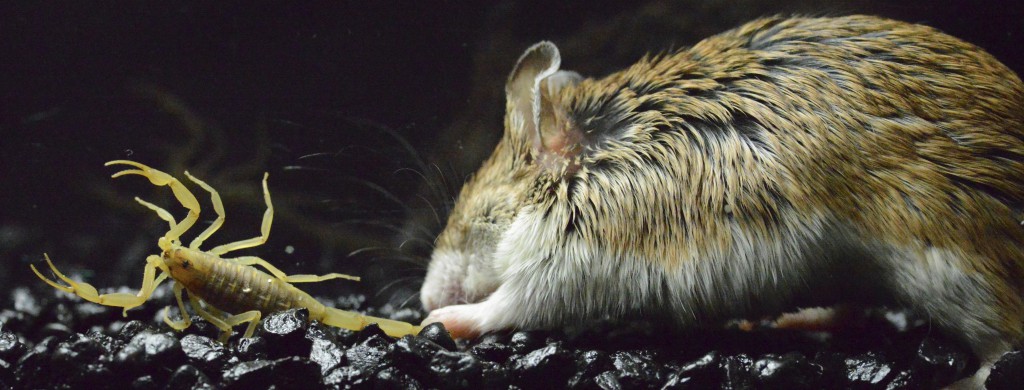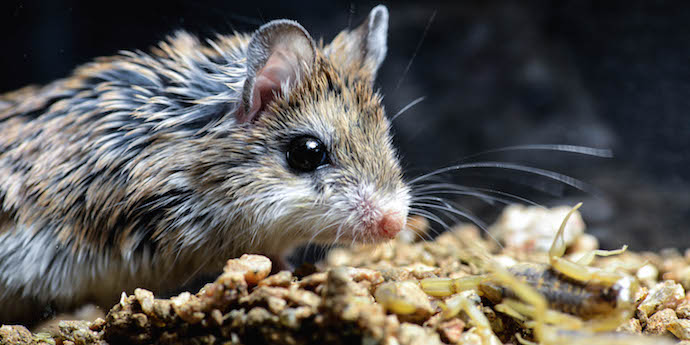You can get the slides from our NABT talk here: A Tail of Two Scorpions
Lizards, iguanas, and snakes! Oh my!
The activities are as follows:
- Teacher Guide
- Student activity, Graph Type A, Level 3
- Student activity, Graph Type B, Level 3
- Student activity, Graph Type C, Level 3
- Grading Rubric
Throughout history people have settled mainly along rivers and streams. Easy access to water provides resources to support many people living in one area. In the United States today, people have settled along 70% of rivers.
Today, rivers are very different from what they were like before people settled near them. The land surrounding these rivers, called riparian habitats, has been transformed into land for farming, businesses, or housing for people. This urbanization has caused the loss of green spaces that provide valuable services, such as water filtration, species diversity, and a connection to nature for people living in cities. Today, people are trying to restore green spaces along the river to bring back these services. Restoration of disturbed riparian habitats will hopefully bring back native species and all the other benefits these habitats provide.
Scientists Heather and Mélanie are researchers with the Central Arizona-Phoenix Long-Term Ecological Research (CAP LTER) project. They want to know how restoration will affect animals living near rivers. They are particularly interested in reptiles, such as lizards. Reptiles play important roles in riparian habitats. Reptiles help energy flow and nutrient cycling. This means that if reptiles live in restored riparian habitats, they could increase the long-term health of those habitats. Reptiles can also offer clues about the condition of an ecosystem. Areas where reptiles are found are usually in better condition than areas where reptiles do not live.
Heather and Mélanie wanted to look at how disturbances in riparian habitats affected reptiles. They wanted to know if reptile abundance (number of individuals) and diversity (number of species) would be different in areas that were more developed. Some reptile species may be sensitive to urbanization, but if these habitats are restored their diversity and abundance might increase or return to pre-urbanization levels. The scientists collected data along the Salt River in Arizona. They had three sites: 1) a non-urban site, 2) an urban disturbed site, and 3) an urban rehabilitated site. They counted reptiles that they saw during a survey. At each site, they searched 21 plots that were 10 meters wide and 20 meters long. The sites were located along 7 transects, or paths measured out to collect data. Transects were laid out along the riparian habitat of the stream and there were 3 plots per transect. Each plot was surveyed 5 times. They searched for animals on the ground, under rocks, and in trees and shrubs.
Featured scientists: Heather Bateman and Mélanie Banville from Arizona State University. Written by Monica Elser from Arizona State University.
Flesch–Kincaid Reading Grade Level = 9.8
Check out this video of Heather and her lab out in the field collecting lizards:
Virtual field trip to the Salt River biodiversity project:
Additional resources related to this Data Nugget:
- For more background on the importance of biodiversity, students can eat this article in The Guardian – What is biodiversity and why does it matter to us?
Data Nuggets are Golden: MSU Awarded $1 Million Grant to Study Science Education Project
 Article originally published on MSU Today. Link to original posting can be found here.
Article originally published on MSU Today. Link to original posting can be found here.
“Data Nuggets rock, and now we can investigate how and why,” said Louise Mead, education director of the BEACON Center for the Study of Evolution in Action, a National Science Foundation funded center headquartered at Michigan State University.
MSU received a $1.1 million grant from the NSF to research the effectiveness of Data Nuggets, a science education project co-designed by MSU scientists and teachers. Data Nuggets are educational activities that bring real scientific data into the classroom, giving students practice interpreting quantitative information and making claims based on evidence. MSU will collaborate in this research with the Biological Sciences Curriculum Study, a non-profit curriculum study committed to transforming science teaching and learning.
“This is what teachers are asking for and it’s well aligned with the next generation of science practices,” said Mead, an evolutionary biologist, researcher and educator. “K-12 teachers see their students struggling in quantitative reasoning skills and science, and they’re looking for new and innovative approaches in the classroom.”
Developed in 2011 at MSU’s Kellogg Biological Station, Data Nuggets are used to engage K-12 students in the practices of science by challenging them to answer a scientific question using data to support their claim. The questions and data are from real research, provided by scientists and presented in a way that is accessible for K-12 classrooms. Students are guided through the construction of graphs to aid data interpretation during the modules, which are offered in a range of scientific research themes, from animal behavior to ecology to agriculture.
“I am so thrilled to see the excitement surrounding Data Nuggets whenever we present them to teachers and scientists,” said Elizabeth Schultheis, who along with fellow postdoctoral researcher Melissa Kjelvik developed Data Nuggets. “And as a scientist I am looking forward to collecting data on Data Nuggets to see if they do what we predict they’ll do.”
The new NSF grant will allow research examining whether short, targeted interventions of classroom activities embedded within a typical curriculum can impact student outcomes. The results could provide teachers with information about supplementing their current lesson plans with classroom activities like Data Nuggets, specifically targeted at improving students’ understanding of science.
“The big picture is that the U.S. is falling behind in math and science, and this might give us a chance to help both teachers and students,” Mead said. “Data Nuggets gives these students a step up, so that when they go to college they’ve already analyzed data and formed hypotheses.”
By providing students with access to authentic science and data, Data Nuggets hopes to bridge the gap between scientists and the public. Scientists who create Data Nuggets lessons will be able to share the process of science and research findings with students and teachers, and help to improve the understanding of science in society.
“Because Data Nuggets originated from a partnership of teachers and scientists, they address both the needs of scientists to share their research broadly and improve their communication skills, and of teachers who need resources that address science reform and teach science in an authentic way,” Schultheis said.
Is your salt marsh in the zone?
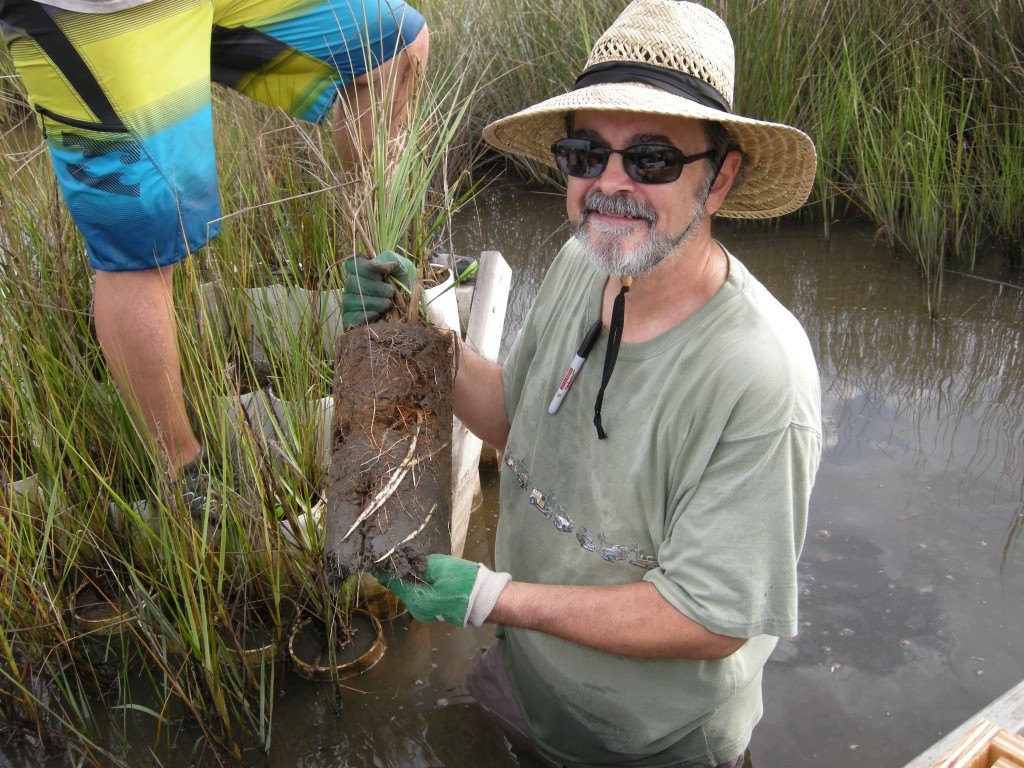
Scientist James collecting plants in a Massachusetts marsh, part of the Plum Island Ecosystems Long Term Ecological Research site
The activities are as follows:
- Teacher Guide
- Student activity, Graph Type A, Level 3
- Student activity, Graph Type B, Level 3
- Student activity, Graph Type C, Level 3
- Grading Rubric
Tides are the rise and fall of ocean water levels, and happen every day like clockwork. Gravity from the moon and sun drive the tides. There is a high tide and a low tide, and the average height of the tide is called the mean sea level. The mean sea level changes seasonally due to the warming and cooling of the ocean throughout the year. It also changes annually due to a long-term trend of ocean warming and the melting of glaciers. Scientific evidence shows that climate change is causing the sea level to rise faster now than it has in the past. As the climate continues to warm, it is predicted that the sea level will continue to rise.
Salt marshes are wetlands with plains of grass that grow along much of the ocean’s coast worldwide. These marshes are important habitats for many plants and animals, and protect our shores from erosion during storms. They grow between mean sea level and the level of high tide. Marshes flood during high tide and are exposed to the air during low tide. The health of a salt marsh is determined by where it sits relative to the tide (the “zone”). A healthy marsh is flooded only part of the time. Too much flooding and too little flooding are unhealthy. Because they are so important, scientists want to know if salt marshes will keep up with sea level rise caused by climate change.
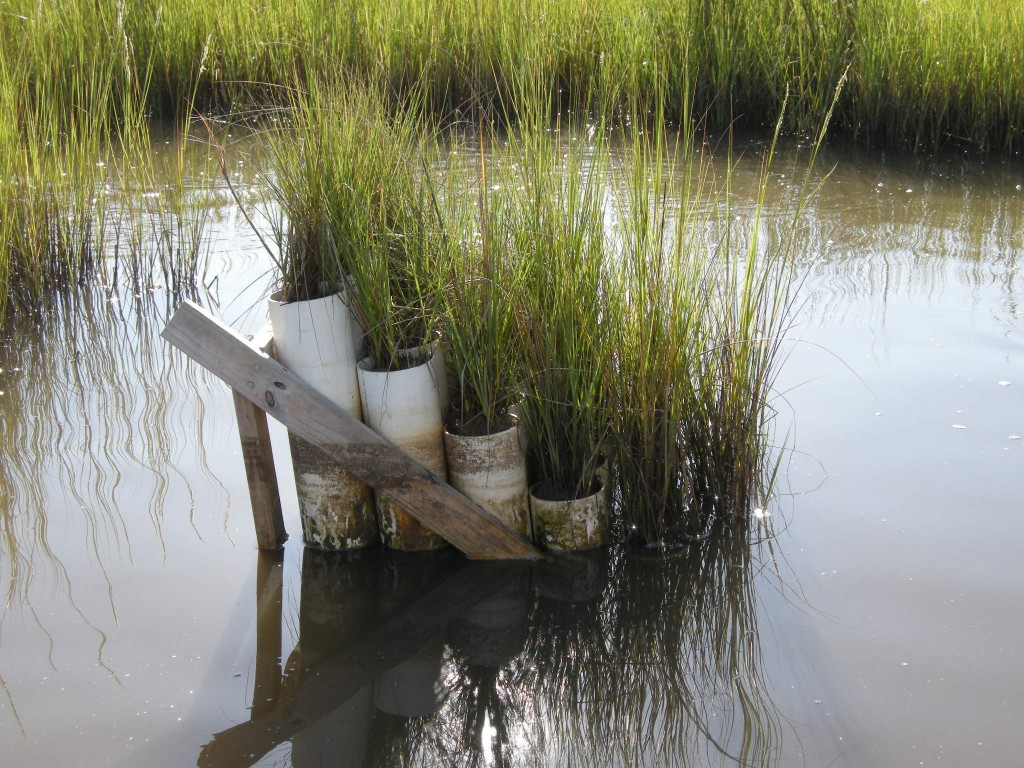
A picture of James’ “marsh organ” which holds plants at different elevations relative to mean sea level. He gave it that name because it resembles organ pipes!
In the 1980s, scientist James began measuring the growth of marsh grasses. He was surprised to find that there was a long-term trend of increasing grass growth over the years. James wanted to know if grasses could continue to keep up with rising sea levels. If he could experimentally manipulate the height of the grasses, relative to mean sea level, he might be able to figure out how grasses will do when sea levels are higher. To test this, James invented a way to experimentally grow a marsh at different elevations relative to mean sea level. He built a device he called the “marsh organ”. This device is made of tubes that stand at different elevations and are filled with marsh mud and planted with marsh grasses. He measured the growth of the grass in each of the pipes. If grasses will continue to grow taller in the future with higher water levels, then plants growing in pipes at lower elevations should grow more than plants growing in pipes with higher elevations.
Featured scientist: James Morris from the University of South Carolina
Additional teacher resource related to this Data Nugget: Jim has created an interactive salt marsh model called the “marsh equilibrium model”. This online tool allows you to plug in different marsh levels to explore potential impacts to the salt marsh. To explore this tool click here.
To read more about Jim’s research on “tipping points” beyond which sediment accumulation fails to keep up with rising sea level and the marshes drown, click here.
There are two publications related to the data included in this activity:
- Morris, J.T., Sundberg, K., and Hopkinson, C.S. 2013. Salt marsh primary production and its responses to relative sea level and nutrients in estuaries at Plum Island, Massachusetts, and North Inlet, South Carolina, USA. Oceanography 26:78-84.
- Morris, J.T., P.V. Sundareshwar, C.T. Nietch, B. Kjerfve, D.R. Cahoon. 2002. Responses of coastal wetlands to rising sea level. Ecology 83:2869-2877.
Invasion meltdown
The activities are as follows:
- Teacher Guide
- Student activity, Graph Type A, Level 3
- Student activity, Graph Type B, Level 3
- Student activity, Graph Type C, Level 3
- Grading Rubric
Humans are changing the earth in many ways. First, by burning fossil fuels and adding greenhouse gasses to the atmosphere we are causing climate change, or the warming of the planet. Scientists have documented rising temperatures across the globe and predict an increase of 3° C in Michigan within the next 100 years. Second, we are also changing the earth by movingspecies across the globe, introducing them into new habitats. Some of these introduced species spread quickly and become invasive. Invasive species harm native species and cost us money. There is also potential that these two changes could affect one another; warmer temperatures from climate change may make invasions by plants and animals even worse.
All living organisms have a range of temperatures they are able to survive in, and temperatures where they perform their best. For example, arctic penguins do best in the cold, while tropical parrots prefer warmer temperatures. The same is true for plants. Depending on the temperature preferences of a plant species, warming temperatures may either help or harm that species.
Katie, Mark, and Jen are scientists concerned that invasive species may do better in the warmer temperatures caused by climate change. There are several reasons they expect that invasive species may benefit from climate change. First, because invasive species have already survived transport from one habitat to another, they may be species that are better able to handle change, like temperature increases. Second, the new habitat of an invasive species may have temperatures that allow it to survive, but are too low for the invasive species to do their absolute best. This could happen if the invasive species was transported from somewhere warm to somewhere cold. Climate change could increase temperatures enough to put the new habitat in the species’range of preferred temperatures, making it ideal for the invasive species to grow and survive.
To determine if climate change will benefit invasive species, Katie, Mark, and Jen focused on one of the worst invasive plants in Michigan, spotted knapweed. They looked at spotted knapweed plants growing in a field experiment with eight rings. Half of the rings were left with normal, ambient air temperatures. The other half of the rings were heated using ceramic heaters attached to the side of the rings. These heaters raised air temperatures by 3° C to mimic future climate change. At the end of the summer, Mark and Katie collected all of the spotted knapweed from the rings. They recorded both the (1) abundance, or number of spotted knapweed plants within a square meter, and (2) the biomass (dry weight of living material) of spotted knapweed. These two variables taken together are a good measure of performance, or how well spotted knapweed is doing in both treatments.
Featured scientists: Katie McKinley, Mark Hammond, and Jen Lau from Michigan State University
Green crabs: invaders in the Great Marsh

Scientist Alyssa holding a non-native green crab, introduced from Europe to the American Atlantic Coast. This crab causes many problems in its new range, including the loss of native eelgrass.
The activities are as follows:
Marshes, areas along the coast that flood with each tide, are incredibly important habitats. They act as homes to large number of species, protect the coast from erosion during storms, and act as a filter for nutrients and pollution. Many species are unique to these habitats and provide crucial support to the marsh. For example, native eelgrass, a type of plant, minimizes erosion by holding sediments in place with their roots.
In an effort to help protect and restore marshes, we must understand current-day issues that are affecting their health. The introduction of non-native species, species that are not originally from this ecosystem, into a marsh may disrupt the marsh ecosystem and threaten the survival of native species. One species that has recently caused a lot of trouble is the European green crab. This crab species was accidentally carried to the Atlantic coast back in the early 1800s from Europe. Since then, they have become extremely invasive and their numbers have exploded! Compared to native crabs, the green crab digs a lot when it searches for food and shelter. This digging uproots eelgrass and causes its population numbers to fall. In many spots where green crabs have been introduced, marshes are now bare and no more grass can grow.
The Great Marsh is one of the coastal habitats affected by invasive green crabs. Located on the North Shore of Massachusetts, the Great Marsh is known for being the longest continuous stretch of salt marsh in all of New England. Alyssa is a restoration ecologist who is very concerned with the conservation of the Great Marsh and other important coastal ecosystems. She and other scientists are trying to maintain native species while also reducing the effects of non-native species.
A major goal for Alyssa is to restore populations of a native eelgrass. Eelgrass does more than just prevent erosion. It also improves water quality, provides food and habitat for native animal species, and acts as an indicator of marsh health. If green crabs are responsible for the loss of eelgrass from the marsh, then restorations where eelgrass is planted back into the marsh should be more successful where green crab numbers are low. Alyssa has been measuring green crab populations in different areas by laying out green crab traps for 24 hours. Alyssa has set these traps around Essex Bay, an area within the Great Marsh. She recorded the total number of green crabs caught at each location (as well as their body size and sex).
Featured scientist: Alyssa Novak, Center for Coastal Studies/Boston University. Written by: Hanna Morgensen
How to Escape a Predator
The activities are as follows:
- Teacher Guide
- Student activity, Graph Type A, Level 4
- Student activity, Graph Type B, Level 4
- Student activity, Graph Type C, Level 4
- Grading Rubric
Stalk-eyed flies are insects that have their eyes on the ends of eyestalks, or long projections from the sides of their head. Eyestalks are a sexual signal that males use to attract females. The longer the eyestalks, the more attractive a male is to females and the more mates he gets. For these flies, sexual selection leads to an elaborate trait, just like a peacock’s tail. Males with longer eyestalks have more babies and pass their traits on. Over generations, sexual selection leads to longer and longer eyestalks in males.
However, these eyestalks may come with a cost. Males with longer eyestalks may not be able to move easily and quickly. If they can’t move as fast, males with long eyestalks are potentially worse at escaping predators. Natural selection may select against long eyestalks if males with more elaborate traits are killed and eaten more often by predators. If predators eat males with longer eyestalks before the flies reproduce, they will not get to pass on their traits, regardless of how attractive they are to females.
In addition to eyestalk length, other traits could affect survival in male stalk-eyed flies. Perhaps the fly’s behavior is more important than its eyestalk length when faced with a predator. When biologists Amy and John first started researching how eyestalk length affected survival, they noticed something intriguing! The flies showed many different behaviors when face to face with a spider predator. Some examples of behaviors included grooming, walking or flying towards the predator, quickly walking or flying away from the predator, displaying forelegs, and bobbing their abdomens. When prey use these antipredator behaviors, predators must put in more work to catch prey, and they will sometimes give up. Therefore, antipredator behaviors may influence the predator’s choice of prey, and certain behaviors that make prey harder to catch could lead to increased survival.
To test whether differences in eye stalk length and/or antipredator behavior were important for survival, male stalk-eyed flies were put in cages with predators. Amy and John filmed the fly behaviors and analyzed the footage. They calculated the frequency and proportion of time that flies were displaying antipredator behaviors. If males with longer eyestalks have lower survival than males with shorter eyestalks, it suggests that longer eyestalks make it harder to avoid predators. However, if eyestalk length has no effect on survival, it suggests that male flies with long eyestalks are able to compensate for their lack of speed through behavior.
Featured scientists: Amy Worthington and John Swallow from Washington State University and University of Colorado, Denver. Written by: Brooke Ravanelli from Denver Public Schools and John Swallow.
Flesch–Kincaid Reading Grade Level = 10.7
There is a scientific paper associated with the data in this Data Nugget. The citation and PDF for the paper is below.
- Worthington, A.M. and J.G. Swallow (2010) Gender differences in survival and antipredatory behavior in stalk-eyed flies. Behavioral Ecology 21 (4):759-766.
Video showing how the long eyestalks of males form!
Videos of a stalk eyed fly and spider predator together in cages. First video shows male fly displaying, grooming, and approaching spider.
Urbanization and estuary eutrophication
The activities are as follows:
- Teacher Guide
- Student activity, Graph Type A, Level 4
- Student activity, Graph Type B, Level 4
- Student activity, Graph Type C, Level 4
- Grading Rubric
An estuary is a habitat formed where a freshwater river or stream meets a saltwater ocean. Many estuaries can be found along the Atlantic coast of North America. Reeds and grasses are the dominant type of plant in estuaries because they are able to tolerate and grow in the salty water. Where these reeds and grasses grow they form a special habitat called a salt marsh. Salt marshes are important because they filter polluted water and buffer the land from storms. Salt marshes are the habitat for many different kinds of plants, fish, shellfish, and birds.
Scientists are worried because some salt marshes are in trouble! Runoff from rain washes nutrients, usually from lawn fertilizers and agriculture, from land and carries them to estuaries. When excess nutrients, such as nitrogen or phosphorus, enter an ecosystem the natural balance is disrupted. The ecosystem becomes more productive, called eutrophication. Eutrophication can cause major problems for estuaries and other habitats.
With more nutrients in the ecosystem, the growth of plants and algae explodes. During the day, algae photosynthesize and release O2 as a byproduct. However, excess nutrients cause these same algae grow densely near the surface of the water, decreasing the light available to plants growing below the water on the soil surface. Without light, the plants die and are broken down by decomposers. Decomposers, such as bacteria, use a lot of O2 because they respire as they break down plant material. Because there is so much dead plant material for decomposers, they use up most of the O2 dissolved in the water. Eventually there is not enough O2 for aquatic animals, such as fish and shellfish, and they begin to die-off as well.
Two features can be used to identify whether eutrophication is occurring. The first feature is low levels of dissolved O2 in the water. The second feature is when there are large changes in the amount of dissolved O2 from dawn to dusk. Remember, during the day when it’s sunny, photosynthesis converts CO2, water, and light into glucose and O2. Decomposition reverses the process, using glucose and O2 and producing CO2 and water. This means that when the sun is down at night, O2 is not being added to the water from photosynthesis. However, O2 is still being used for decomposition and respiration by animals and plants at night.
The scientists focused on two locations in the Plum Island Estuary and measured dissolved O2 levels, or the amount of O2 in the water. They looked at how the levels of O2 changed throughout the day and night. They predicted that the upper part of the estuary would show the two features of eutrophication because it is located near an urban area. They also predicted the lower part of the estuary would not be affected by eutrophication because it was farther from urban areas.
Featured scientists: Charles Hopkinson from University of Georgia and Hap Garritt from the Marine Biological Laboratory Ecosystems Center
Can a salt marsh recover after restoration?
The activities are as follows:
- Teacher Guide
- Student activity, Graph Type A, Level 2
- Student activity, Graph Type B, Level 2
- Student activity, Graph Type C, Level 2
- Grading Rubric
Éste Data Nugget también está disponible en Español:
- Actividad para estudiantes, Tipo de gráfica A
- Actividad para estudiantes, Tipo de gráfica B
- Actividad para estudiantes, Tipo de gráfica C
In the 1990s, it was clear that the Saratoga Creek salt marsh was in trouble. The invasive plant, Phragmites australis, covered large areas of the marsh. Thick patches of Phragmites crowded out native plants. There were very few animals, especially migrating birds, because the plants grew too densely for them to move around.
Salt marshes are wetland habitats near oceans where water-tolerant salt-loving plants grow. Usually native grasses dominate the marsh, but where humans cause disturbance Phragmites can start to take over. Human disturbance was having a huge effect on the health of Saratoga Creek by changing the water coming into the marsh. Storm drains, built to keep rain water off the roads, were adding more water to the marsh. This runoff, or freshwater and sediments from the surrounding land, made the marsh less salty. The extra sediment made the problem even worse because it raised soil levels along the road. Raised soil means less salty ocean comes into the marsh during high tide.
In 1998, scientists, including members of the Rockport Conservation Commission and students from the Rockport Middle School science club, began to look at the problem. Phragmites grows best when salt levels are low. When salt levels are high, native grasses do better. The scientists thought that the extra fresh water and sediments added by the storm drains into the marsh was the reason Phragmites was taking over.
The scientists wanted to see if a restoration could reverse the Phragmites invasion. In 1999, a ditch was dug along the side the road to catch runoff before it entered the marsh. A layer of sediment was also removed from the marsh, allowing ocean water to reach the marsh during high tide once again. Students set up sampling areas, chosen to observe and record data, called transects. Transects were 25 meters long and students collected data every meter. The transects made it possible to return to the same points in the marsh year after year. Along the transects, students counted the number of Phragmites plants and calculated abundance as the percent of points along the transect where they found Phragmites. They also measured the height of Phragmites as a way to figure out how well it was growing.
The students compared Phragmites data from before 1999 and after 1999 to see if the restoration made a difference. They predicted that the abundance and height of Phragmites would go down after runoff was reduced by the restoration.
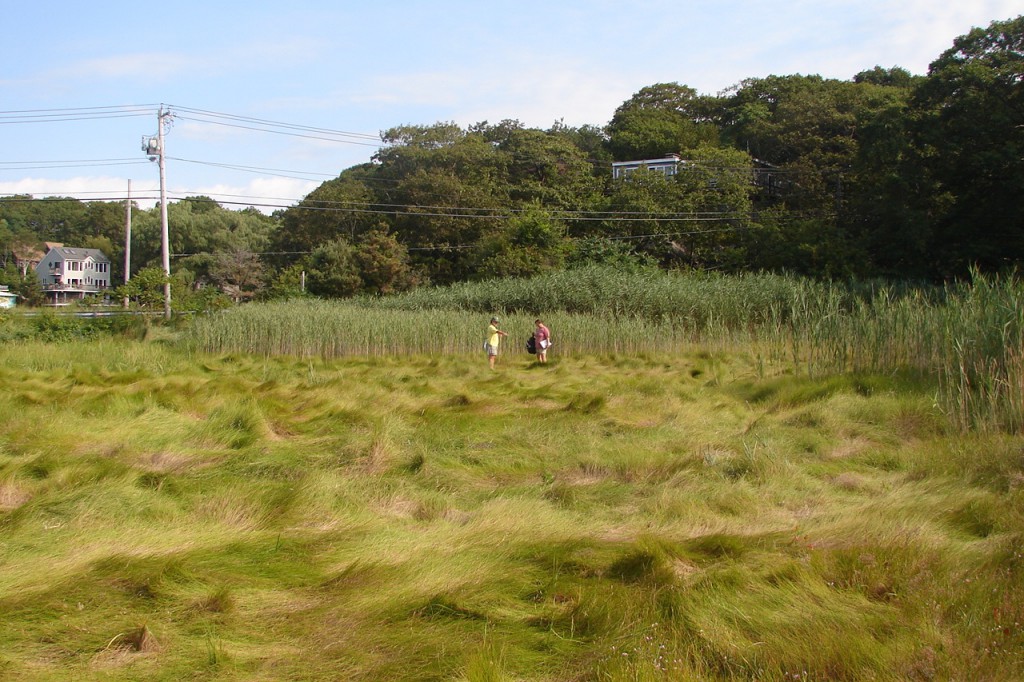
View of Saratoga Creek Salt Marsh several years after restoration, showing location of one of the transects. Native grasses are growing in the foreground.
Featured scientists: Liz Duff from Mass Audubon, Eric Hutchins from NOAA, and Bob Allia and 7th graders from Rockport Middle School
Written by: Bob Allia, Cindy Richmond, and Dave Young
Flesch–Kincaid Reading Grade Level = 8.9
For more information on this project, including datasets and more scientific background, check out their website: Salt Marsh Science
A tail of two scorpions
The activities are as follows:
- Teacher Guide
- Student activity, Graph Type A, Level 2
- Student activity, Graph Type B, Level 2
- Student activity, Graph Type C, Level 2
- Powerpoint of Images
- Grading Rubric
- Digital Data Nugget on DataClassroom
Animals have evolved many ways to defend themselves against predators. Many species use camouflage to avoid being seen. Others rely on speed to escape. Some species avoid capture by hiding in a safe place. Other animals use painful and venomous bites or stings to try to prevent attacks or to make being captured more difficult. Anyone who has been stung by a bee or wasp understands how stinging could be a great way to keep predators away! However, there is little research that documents if painful stings or bites deter predators.
The grasshopper mouse lives at the base of the Santa Rita Mountains in Arizona. Scientists Ashlee and Matt have been studying populations of this mouse for many years and wanted to know what the mouse ate. In the mountains, there are two scorpions that make a great food source for the mice. One of the scorpion species has a painful sting. The other species is slightly larger, but its sting is not painful. Ashlee and Matt thought that the use of a painful, venomous sting helped the smaller species avoid most predator attacks.
The scientists collected six grasshopper mice from the wild. Back in the lab, they trained the mice to expect a food reward when they tipped over a small cup containing live prey. Once trained, the mice were used in an experiment. The mice were presented with two cups to choose from. One contained the small scorpion species that has a painful sting. The other cup contained the larger scorpion species that has a painless sting. Ashlee and Matt collected data on which cup the mice chose to approach, inspect, or pursue (by tipping over the cup). They also recorded if the mice attacked or consumed the painless or painful species of scorpion. Each trial ended when the mouse finished consuming one of the scorpions. If painful stings prevent a predator from attacking, they predicted the mice would choose to eat the scorpion species with the painless sting more often.
Watch a video of one of the experimental trials:
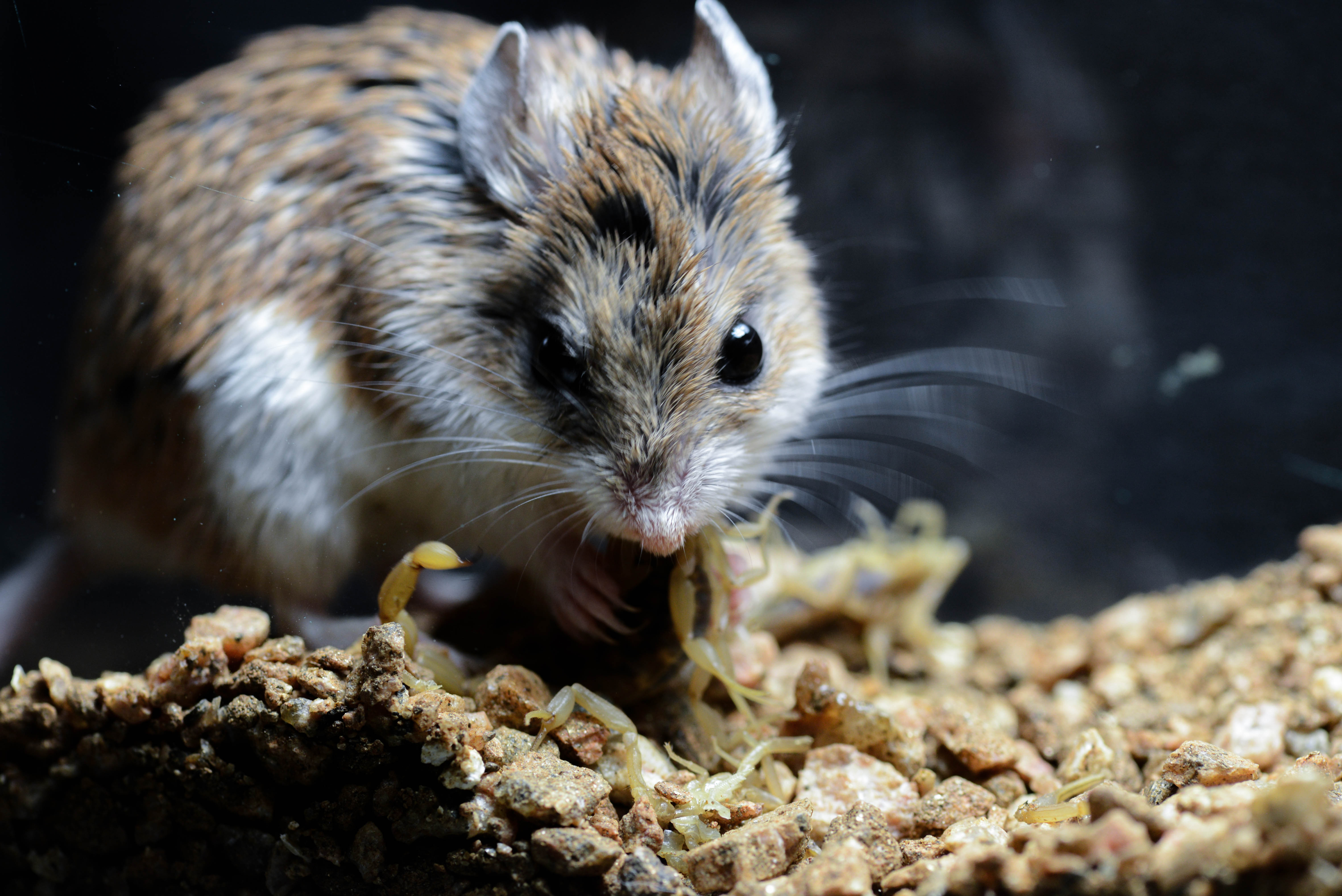
Watch five additional videos on the grasshopper mouse and scorpions:
- A video on the grasshopper mouse and how it deals with scorpion venom
- The Anomalies: Venom Race
- Deep Look: Stinging Scorpion vs. Pain-Defying Mouse
- Video of grasshopper mouse battling and consuming bark scorpion
- Scorpion Hunters – See the Rowe lab as they go out into the field to collect scorpions for their research
Images of the southern grasshopper mouse (Onychomys torridus) capturing and eating the painful species of scorpion (Centruroides sculpturatus).
Size differences of the two scorpions used in the experiments (painful Arizona bark scorpion, Centruroides sculpturatus is on the left; painless stripe-tailed scorpion, Hoffmannius spinigerus on the right)
Featured scientists: Ashlee and Matt Rowe from University of Oklahoma
Undergraduate researchers involved with the project: Travis Tate and Crystal Niermann from Sam Houston State University; Rolando Barajas, Hope White, and Amber Suto from Michigan State University
Flesch–Kincaid Reading Grade Level = 7.1
